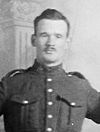
838045 Pte. Charles Colyer was born in London, England, on October 17th, 1887. As a "Home Boy" Charles underwent emigration to Canada for "a better life" as part of the First Emigration Party of 1900 organized by a philanthropic organization founded by Dr. Barnardo. The term "Barnardo Boys" would also become synonymous with the whole forced immigration of children.
Thirteen year old Charles was taken in by the Abra family of Bognor, Ontario, where he was employed. In 1903 he received a silver medal from the Barnardo organization for good conduct and length of service.
Eventually striking out on his own, the twenty-eight year old Charles was farming in the Bognor area when he attested to the 147th (Grey) Battalion on November 27th, 1915.
Billeted locally over the winter, the 147th Battalion mobilized in the spring of 1916 and departed for the training grounds of Camp Niagara. As the conditions in the Camp were wanting the unit moved to the new training facility of Camp Borden in late June. In September the unit received their orders to proceed overseas, but due to an outbreak of diphtheria they were detained in Amherst, Nova Scotia, for over a month. The unit finally sailed for Great Britain on November 14th, 1916, on the S.S. Olympic, a sister ship to the Titanic.
On January 1st, 1917, the 147th Battalion ceased to exist when it became the nucleus for the 8th Reserve Battalion, whose task it was to supply reinforcements to the 58th Battalion and the 4th C.M.R. Some 354 former 147th Battalion men were transferreed to the 4th C.M.R. through the course of the war, and Charles was taken on strength with the 4th C.M.R. on March 7th, 1917.
Charles fought in the Battle of Arras, a battle that saw the Canadian Corps storm Vimy Ridge. Continuing to serve with the unit throughout the war, through Passchendaele, Amiens, Arras, Cambrai and the Pursuit to Mons, Charles came through it all without any noted incident.
Private Charles Colyer was struck off strength from the 4th C.M.R. on March 29th, 1919.
Biography and image credit: George Auer